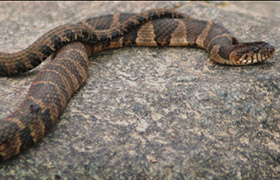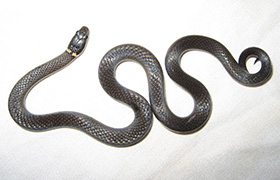Common Snakes of Virginia: Virginia has many different habitats to offer any wildlife but it seems to be one of the best environments for snakes, with a number of different species (both venomous and non-venomous) recorded here.
There are mountainous regions alongside arid plateaus, and there are plenty of forests too, a particular favorite for many snake species and subspecies. With ridge-line peaks, ridge-flats up high, and even valleys with farmland and vegetation,
there’s plenty of places for a snake to hide. And it’s pretty too.
Call the below number for snake removal help in your area:
Arlington/Alexandria/Fairfax County: 703-881-3164
Charlottesville: 434-333-7605
Norfolk/Virginia Beach: 757-550-4886
Richmond: 804-621-7450
Here are the common snakes of Virginia:

Eastern Garter Snake: Some people call it a Garden Snake or Gardner Snake. A medium-sized snake that can measure up to 26 inches (the longest recorded was just under 49 inches long), the eastern garter snake is renowned for eating a pretty wide and diverse diet, choosing worms, slugs, frogs and toads where they can.
A “widespread and ubiquitous” snake, you can find this animal virtually anywhere from highly populated residential areas to grassy fields, trash dumps, stone walls, lakes and other water-logged areas (for their prey) and even in city cemeteries and parks.
A “widespread and ubiquitous” snake, you can find this animal virtually anywhere from highly populated residential areas to grassy fields, trash dumps, stone walls, lakes and other water-logged areas (for their prey) and even in city cemeteries and parks.

Rat Snake: There are two rat snakes in the list of common snakes of Illinois - the Great Plains Ratsnake and the Gray Ratsnake. Slightly larger constricting snakes, some species can grow to over 10 feet in length although most are in the region of two to four feet, docile in nature again making them great pets for snake lovers.
The Corn Snake is another example of a rat snake, and is another common species found within Illinois although more commonly as pets.
The Corn Snake is another example of a rat snake, and is another common species found within Illinois although more commonly as pets.

Northern Black Racer: A slightly larger snake measuring a maximum 60 inches in length, the northern black racer is a particularly striking dark-colored snake with large eyes, completely harmless although it may appear otherwise.
This snake is often confused with another snake commonly found in Virginia - the Eastern Rat Snake, and another subspecies - the Black Rat Snake.
This snake is often confused with another snake commonly found in Virginia - the Eastern Rat Snake, and another subspecies - the Black Rat Snake.

Northern Water Snake: These look like the highly venomous water moccasin or cottonmouth but you don’t need to worry, the northern water snake is entirely non-venomous and isn’t looking for a fight. It would take quite a lot to work this snake up but if you harass it for long enough, it will coil up and snap.
You may also spot the Plain Belly Water Snake, Northern Red Belly Snake and Brown Water Snake in Virginia although these are less common.
You may also spot the Plain Belly Water Snake, Northern Red Belly Snake and Brown Water Snake in Virginia although these are less common.

Eastern Hognose: The shape of this snake’s nose is what gives it it’s name, an upturned shape just right for digging up frogs and toads from wet soils around ponds, streams, lakes and marshes. Although non-venomous, this snake has a habit of copying the actions of venomous snakes, flattening its head to look like a cobra.

Ring-Necked Snake: You’ll find two species of this snake in Virgina - Northern Ring-Necked Snake and Southern Ring-Necked Snake, both secretive, nocturnal creatures that you probably won’t ever see in your lifetime. These snakes do not want to be bothered or harassed and it camouflages very well into habitat surroundings - rocky hillsides and open woodlands, wide open spaces with cover, forests, etc.

Northern Scarlet Snake: Another very popular snake that can be found in most parts of the east and south USA, this small snake (maximum length around 20 inches) won’t make itself obvious. In fact, there’s a good chance you won’t ever see one, a very secretive snake that has a penchant for agriculture and farming land, areas of open forests, and vegetation in soft and moist soils.
Northern Brown Snake
This subspecies of brown snake is one that eats snails, slugs and earthworms as well as other bugs or beetles. This means your back yard is the perfect five star restaurant, one reason why you may spot this snake on your property. Measuring only around twelve inches or so, you may never see this small snake, a grey or brown color with a centre border that’s lighter in color.
Eastern Worm Snake
If you can find wetlands and woodlands, preferably a happy combination of the two close together, you may encounter an eastern worm snake, a snake that also seems to like the grasslands situated in close proximity to forests and woodlands. Burrowing underground is generally where you’ll find them although they do verge overground at times. If you’ve got rotten wood in your yard, or rocks, leaves, logs and other garden debris, you may find one of these, hunting for prey including worms, slugs, snails, earthworms, and other bugs you’ll commonly find in your back yard.
Mole Kingsnake
This one looks a little bit like the humble corn snake, the snake commonly kept as pets. Although very similar, this snake isn’t quite as docile as it’s corn-cousin. You may also see a number of other kingsnakes including:
- Eastern Kingsnake
- Eastern Black Kingsnake
- Scarlet Kingsnake
Eastern Smooth Earth
This is one of the smallest snakes you’ll come across, only getting to about thirteen inches in length, and it’ll actually do you a favor if you leave it to its own devices. Often found in loose soil and leaves, they eat things like earthworms and beetles, keeping insects down in your yard. As well as these common snakes of Virginia, you may also find the following less-common snake species recorded in the state:
- Eastern Mudsnake
- Rainbow Snake
- Rough Earth
- Northern Rough Greensnake
- Smooth Greensnake
- Red Cornsnake
- Northern Pinesnake
- Glossy Crayfish Snake
- Queen Snake
- South Eastern Crown
- Common Ribbonsnake
- Mountain Earth
Venomous Snakes of Virginia
All three venomous snakes of Virginia are pit vipers - the Northern Copperhead, Timber (or Canebrake) Rattlesnake, and the Eastern Cottonmouth.
For more information, go to my Snake Removal - How to Get Rid of Snakes home page.